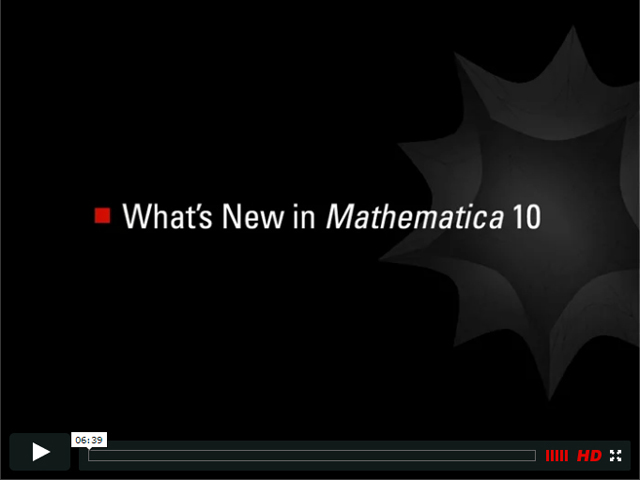 |
Mathematica is renowned as the world's ultimate application for
computations. But it's much more—it's the only development platform
fully integrating computation into complete workflows, moving you
seamlessly from initial ideas all the way to deployed individual or
enterprise solutions.
With more than 25 years of experience and millions of users from Fortune
500 companies to government departments to thousands of universities
worldwide,
Mathematica technology lies behind many of the world's most impressive projects, processes, and organizations.
|
|
|
What's New in
Mathematica 10? See video
|

|
|
|
Top Reasons to Upgrade to Mathematica
10:
|

|
Optimize your workflow with the Wolfram Predictive Interface
The Wolfram Predictive Interface makes it easy to find and use the power of
Mathematica 10. The Input Assistant's context-sensitive autocompletion and dynamic
highlighting help you discover and enter commands, and the
next-computation Suggestions Bar offers optimized suggestions for what
to do next. It's the next step in our ongoing Compute-as-You-Think
initiative that began with free-form linguistic input.
|

|

|
Examine social networks with built-in links to social media
Mathematica 10 introduces a full suite of social
network analysis features including community detection, cohesive
groups, and centrality measures, plus built-in links to Facebook,
LinkedIn, Twitter, and more. It also adds new capabilities for network
flows and new graph distributions.
|

|

|
Work with systemwide support for units
Mathematica 10 introduces a new unit system containing
more than 4,500 different units, all integrated with Wolfram|Alpha's
sophisticated unit interpretation system. From unit conversion to
dimensional analysis,
Mathematica provides you with all the tools you need to work with, and extract properties from, units and quantities.
|

|

|
Use survival analysis, random processes, and other expanded capabilities in data science and visualization
Mathematica 10 offers more statistical distributions
than any other system, including specialized coverage of finance,
medicine, and engineering.
Mathematica 10 adds survival and
reliability analysis; full support for random processes including
queues, time series, and stochastic differential equations; a complete
set of customizable gauges for dashboards and reports; and systemwide
support for automatic legends for plots and charts.
|

|

|
Integrate R code into your Mathematica workflow
Mathematica 10 offers built-in ways to integrate R code into your Mathematica workflow, allowing data exchange between Mathematica and R and execution of R code from within Mathematica. With RLink, R users can use thousands of functions from across the full Mathematica system.
|

|

|
Deploy interactive documents with enhanced capabilities
Instantly create documents in the Computable Document Format
(CDF) to present interactive charts of results, show dynamic models, or
prototype your next application, and deploy them to the web or desktop.
With
MathematicaEnterprise Edition, you can deploy CDFs with live data and other enhanced features.
|

|

|
Perform powerful 3D volumetric and out-of-core image processing
Mathematica 10 scales up performance to very large 2D-
and 3D-volumetric images using out-of-core technology, and builds in a
hardware-accelerated rendering engine for 3D images and volumes.
Mathematica
10
also adds feature tracking, face detection, image enhancements, and
other highly optimized algorithms to perform comprehensive image
analysis.
|

|

|
Use integrated analog and digital signal processing
Filter and analyze sound, images, and multidimensional data with
Mathematica 10's signal processing capabilities. Instantly design and deploy interactive filters and simulate them with Wolfram SystemModeler.
|

|
|
|
|
|
|
|
|